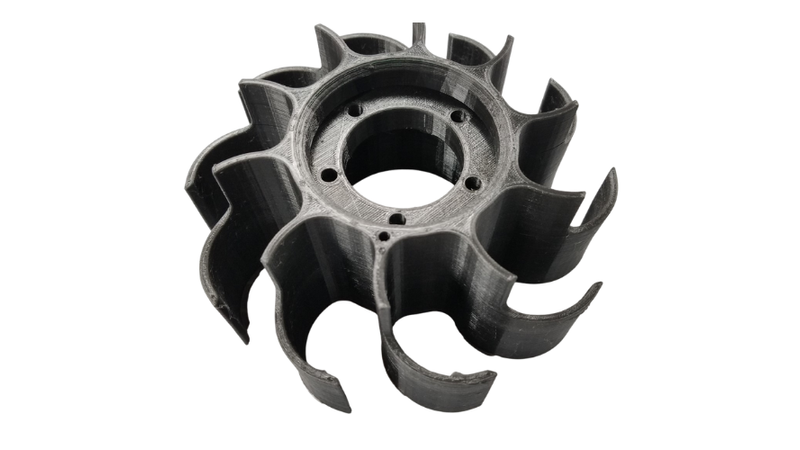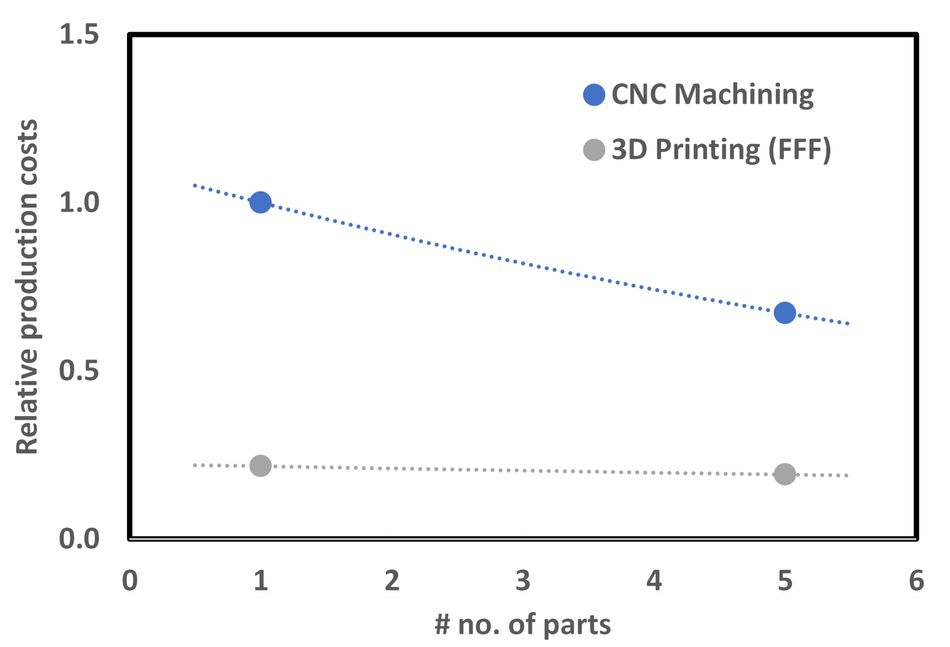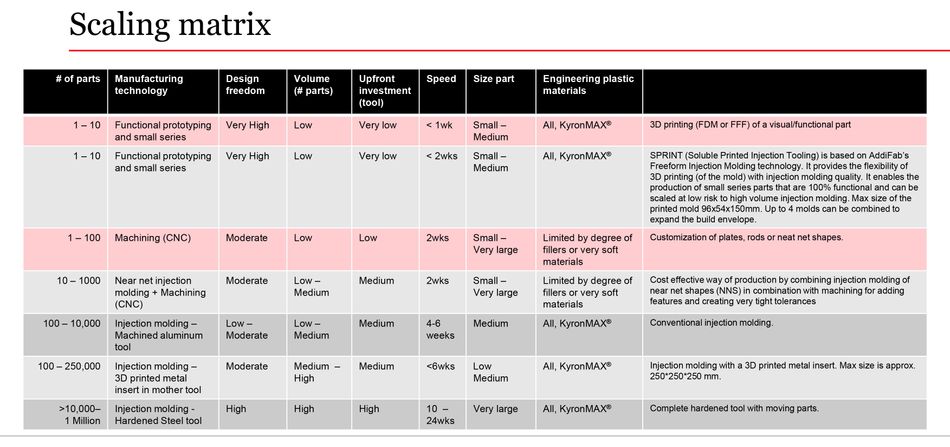Sorting Wheel: CNC Machining vs. 3D Printing (FFF)
Relative production cost comparison between CNC Machining and 3D Printing (FFF, Fused Filament Fabrication) of a sorting wheel.

Sorting wheel example produced at Mitsubishi Chemical Advanced Materials.
Case Study Objective
Relative production cost comparison between CNC Machining and 3D Printing (FFF, Fused Filament Fabrication) of a sorting wheel.
Both CNC Machining as well as 3D Printing can be used for functional prototyping and small series production. In this case study, the production of 1 and 5 pieces are taken into account.
Application Description
This part is used in an automated sorting operation. It is a non-standard part that only requires 1-5 pieces to be replaced every year. Due to the low volume, injection molding is not practical nor cost efficient and so it is traditionally machined out of a large rod of nylon. Due to the thin fins of the design, machining is a tedious and time intensive process that results in a large amount of waste material.
Input Parameters
| CNC Machining | 3D Printing (FFF) | |
| Material | Nylon (polyamide) | Nylon (polyamide) |
| Approx. part dimensions | 6.75”x 6.75”x 3” (172 mm x 172 mm x 76 mm) | §6.75”x 6.75”x 3” (172 mm x 172 mm x 76 mm) |
| Required material for part | 4.8 lbs (2,175g) | 0.85 lbs (388g) |
| Tolerance | ±0.005” (±0.127 mm) | ±0.010” Z-Direction (±0.25 mm) / ±0.040” XY-Direction (±1 mm) |
| Surface finish | √125 RMS | Varies depending on location, fairly rough in Z-direction |
| Approx. fabrication time | 20 hours with fixture build (12 hours CNC time) | 7.25 hours |
Cost comparison
In this example, 3D printing of prototypes or small series production is significantly lower in costs. To choose the right production technology, other requirements such as surface finish, dimensional accuracy, part size, production time, and production waste need to be taken into account. Some of these requirements can be overcome by utilizing post-processing techniques.
To facilitate smooth scaling of your product, you could consider hybrid production technologies, such as 3D printing of the tool for injection molding: SPRINT (Soluble Printed Injection Tooling). This technology requires relative low investment upfront and will result in very reproducible scaling when shifting to hardened steel tooling (high upfront investment) when volumes are increasing.


The High-Temperature Carbon-Fiber 3D Printing Challenge
The High-Temperature Carbon-Fiber 3D Printing Challenge invites you to submit a design that makes use of a newly developed, cutting-edge carbon-fiber material.
Winners of the Challenge will be among the first in the world to use this new material and receive $25,000 worth of manufacturing support to create a fully developed prototype.
Your submission can be a stand-alone product or a component of a larger design. Successful submissions will need to show how the design uses the strength and high-temperature abilities of KyronMAX® carbon-fiber filament combined with the versatility and economics of 3D printing. This combination offers the opportunity for:
- Strong enough for end products.
- Low-cost for single objects and small batches.
- Form freedom.
- Suitable for high-temperature applications, even under challenging environments (hot oil, humidity, coolants, oil, grease, glycol, salts, acidic, etc.).
The new carbon-fiber composite filament is being developed for Fused Filament Fabrication (FFF) 3D printing. With the addition of this product, Mitsubishi Chemical Advanced Materials aims to demonstrate the potential of directly 3D printing carbon-fiber composite parts, while still benefiting from the properties of the high-strength material.
Read more at the Challenge's homepage.
About the sponsor: Mitsubishi Chemical Advanced Materials
Mitsubishi Chemical Advanced Materials is a leading global manufacturer of high-performance materials in the form of semi-finished products and finished parts. The company has locations in 20 countries and more than 2,800 employees. Its specialty engineering thermoplastics and composites are superior in performance to metals and other materials and are used in a wide range of applications, primarily in the capital goods industry. The company is continuously developing new areas of applications in close cooperation with industry leaders in a broad variety of customer markets. The Mitsubishi Chemical Advanced Materials Group is well prepared to further expand its market leadership position.
Supporting the vision of our holding company, Mitsubishi Chemical Holdings Corporation (MCHC), Mitsubishi Chemical Advanced Materials is committed to the realization of KAITEKI, “a sustainable condition which is comfortable for people, society and the Earth”. To realize this vision, the MCHC Group engages in corporate activities that provide products, technologies and services based on the comprehensive capabilities of the Group in the Performance Products Domain, Industrial Materials Domain and Health Care Domain, with chemistry as the basis of our activities. We jointly express and promote our commitment under the corporate brand THE KAITEKI COMPANY.

